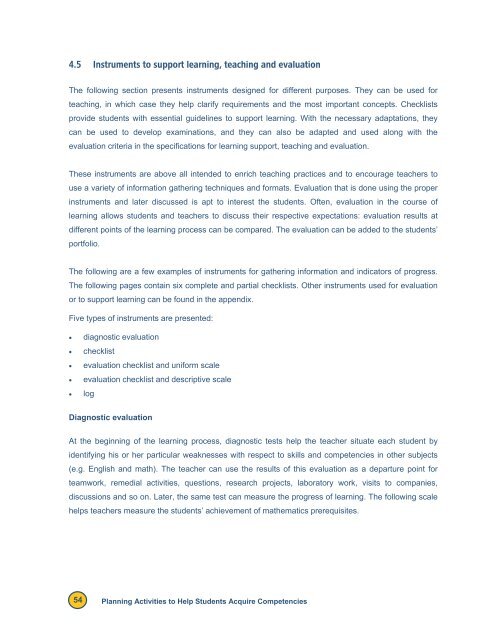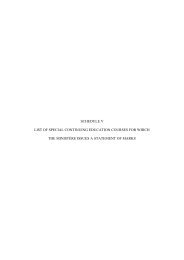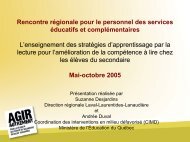Reference Framework for Planning Learning and Evaluation Activities
Reference Framework for Planning Learning and Evaluation Activities
Reference Framework for Planning Learning and Evaluation Activities
You also want an ePaper? Increase the reach of your titles
YUMPU automatically turns print PDFs into web optimized ePapers that Google loves.
4.5 Instruments to support learning, teaching <strong>and</strong> evaluation<br />
The following section presents instruments designed <strong>for</strong> different purposes. They can be used <strong>for</strong><br />
teaching, in which case they help clarify requirements <strong>and</strong> the most important concepts. Checklists<br />
provide students with essential guidelines to support learning. With the necessary adaptations, they<br />
can be used to develop examinations, <strong>and</strong> they can also be adapted <strong>and</strong> used along with the<br />
evaluation criteria in the specifications <strong>for</strong> learning support, teaching <strong>and</strong> evaluation.<br />
These instruments are above all intended to enrich teaching practices <strong>and</strong> to encourage teachers to<br />
use a variety of in<strong>for</strong>mation gathering techniques <strong>and</strong> <strong>for</strong>mats. <strong>Evaluation</strong> that is done using the proper<br />
instruments <strong>and</strong> later discussed is apt to interest the students. Often, evaluation in the course of<br />
learning allows students <strong>and</strong> teachers to discuss their respective expectations: evaluation results at<br />
different points of the learning process can be compared. The evaluation can be added to the students’<br />
portfolio.<br />
The following are a few examples of instruments <strong>for</strong> gathering in<strong>for</strong>mation <strong>and</strong> indicators of progress.<br />
The following pages contain six complete <strong>and</strong> partial checklists. Other instruments used <strong>for</strong> evaluation<br />
or to support learning can be found in the appendix.<br />
Five types of instruments are presented:<br />
• diagnostic evaluation<br />
• checklist<br />
• evaluation checklist <strong>and</strong> uni<strong>for</strong>m scale<br />
• evaluation checklist <strong>and</strong> descriptive scale<br />
• log<br />
Diagnostic evaluation<br />
At the beginning of the learning process, diagnostic tests help the teacher situate each student by<br />
identifying his or her particular weaknesses with respect to skills <strong>and</strong> competencies in other subjects<br />
(e.g. English <strong>and</strong> math). The teacher can use the results of this evaluation as a departure point <strong>for</strong><br />
teamwork, remedial activities, questions, research projects, laboratory work, visits to companies,<br />
discussions <strong>and</strong> so on. Later, the same test can measure the progress of learning. The following scale<br />
helps teachers measure the students’ achievement of mathematics prerequisites.<br />
54 <strong>Planning</strong> <strong>Activities</strong> to Help Students Acquire Competencies




